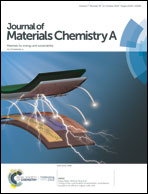Self-supported tripod-like nickel phosphide nanowire arrays for hydrogen evolution†
Abstract
Nickel phosphide catalysts have drawn considerable attention due to their high catalytic activities for the hydrogen evolution reaction (HER). Current research studies mainly focus on the development of nickel phosphide nanoparticles, nanosheets and so on; however, less effort has been made towards the design of self-supported nickel phosphide nanowires (NWs) for the HER. Herein, we develop a new strategy for the fabrication of self-supported NixP NWs on Ni foam (NixP/NF). The strategy involves the removal of Mo cations in nickel molybdate NWs under electrochemical oxidation conditions and a subsequent phosphorization process. The resultant NixP NWs supported on a NF substrate exhibit a tripod-like topography and thus they have excellent activity and stability toward the HER. The optimized NixP NWs need a small overpotential of 71 mV to deliver 10 mA cm−2. Meanwhile, at a large current density above 360 mA cm−2, the optimized self-supported NixP NWs can catalyze the HER stably over 40 h without obvious decay in the activity, superior to the benchmark Pt/C catalyst. Our findings also highlight that the molybdenum cations in some molybdenum-containing nanostructures such as metal molybdate NWs can be dissolved in alkaline media under electrochemical oxidation conditions, and then provide a new strategy for high-performance metal phosphide catalysts.



 Please wait while we load your content...
Please wait while we load your content...